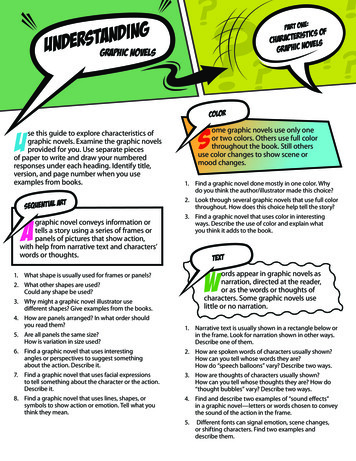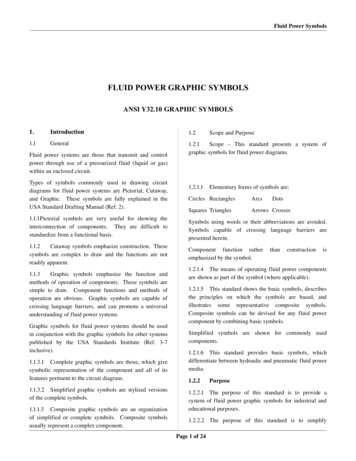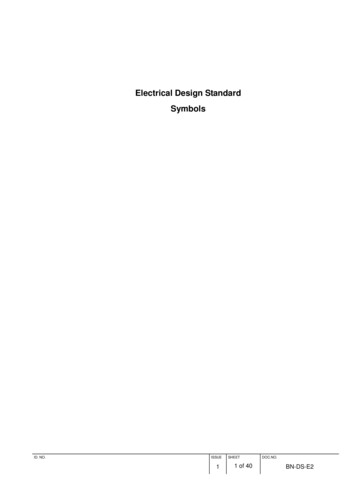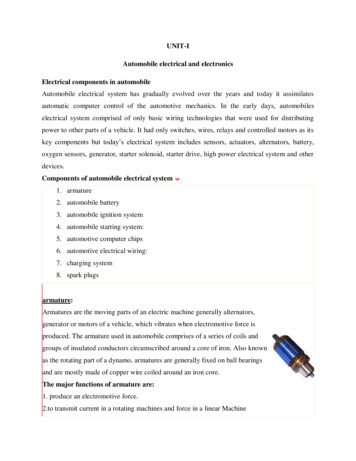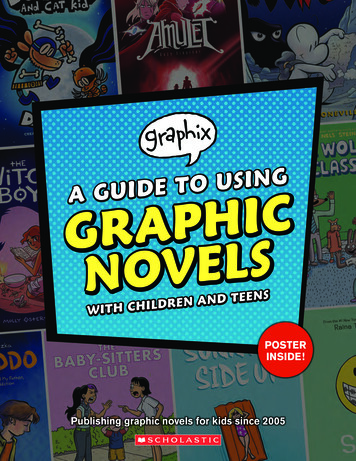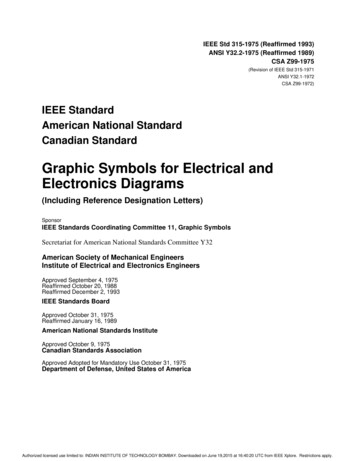
Transcription
IEEE Std 315-1975 (Reaffirmed 1993)ANSI Y32.2-1975 (Reaffirmed 1989)CSA Z99-1975(Revision of IEEE Std 315-1971ANSI Y32.1-1972CSA Z99-1972)IEEE StandardAmerican National StandardCanadian StandardGraphic Symbols for Electrical andElectronics Diagrams(Including Reference Designation Letters)SponsorIEEE Standards Coordinating Committee 11, Graphic SymbolsSecretariat for American National Standards Committee Y32American Society of Mechanical EngineersInstitute of Electrical and Electronics EngineersApproved September 4, 1975Reaffirmed October 20, 1988Reaffirmed December 2, 1993IEEE Standards BoardApproved October 31, 1975Reaffirmed January 16, 1989American National Standards InstituteApproved October 9, 1975Canadian Standards AssociationApproved Adopted for Mandatory Use October 31, 1975Department of Defense, United States of AmericaAuthorized licensed use limited to: INDIAN INSTITUTE OF TECHNOLOGY BOMBAY. Downloaded on June 19,2015 at 16:40:20 UTC from IEEE Xplore. Restrictions apply.
IEEE Std 315-1975(ANSI Y32.2-1975)31 October, 1975Acceptance NoticeThe following Industry Standardization Document was adopted on 31 October 1975 for mandatory use by the DoD.The indicated industry groups have furnished the clearances required by existing regulations. Copies of the documentsare stocked by DoD Single Stock Point, Naval Publications and Forms Center, Philadelphia, PA, 19120, for issue tomilitary activities only.Title of Document: Graphic Symbols for Electrical and Electronics Diagrams (Including Reference Designation ClassDesignation Letters)Document No. (a) IEEE Std 315-1975(b) ANSI Y32.2-1975Date of Specific Issue Adopted: (a) 4 September, 1975(b) 31 October, 1975Releasing Industry Group: (a) The Institute of Electrical and Electronics Engineers, Inc.(b) American National Standards Institute, Inc.Supersedes:IEEE Std 315-1971(ANSI Y32.2-1970)Custodians:Army - ELNavy - SHAir Force - 16Military Coordinating Activity:Army - ELReview Activities:Army - AV, MI, MUNavy AS, OS, SH, YDUser Activities:Army - MENavy - EC, MCProject Number: DRPR-0176Certain provisions of this standard are subject of International Standardization Agreement, ABC NAVY STD-28A,Symbols and Abbreviations for Electrical and Electronics Drawings, to which the U.S. Army also subscribes. Whenreaffirmations, amendment, revision, or cancellation of this standard is proposed which will effect or violate theinternational agreement concerned, the Military Coordinating Activity will take appropriate reconcilliation actionthrough military international standardization channels including departmental standardization offices, if required.NOTICE: When reaffirmation, amendment, revision, or cancellation of this standard is initially proposed, thecognizant secretariat of the industry standard shall inform the Military Coordinating Activity of the proposed changeand request their participation.iiAuthorized licensed use limited to: INDIAN INSTITUTE OF TECHNOLOGY BOMBAY. Downloaded on June 19,2015 at 16:40:20 UTC from IEEE Xplore. Restrictions apply.
Preface to CSA Standard Z99-1975 C11BGraphic Symbols for Electrical and Electronics DiagramsREXDALE, October 9, 1975American National Standard Y32.2-1975 (IEEE Std 315-1975), with the modifications shown in Section 100, has beenapproved as CSA Standard Z99. This action was proposed by the Committee on Electrical Symbols, under thejurisdiction of the Sectional Committee on Abbreviations, Definitions and Symbols and was formerly approved bythese Committees.See Section 100, Canadian Standard Z99 modifications to American National Standard Y32.2-1975 on page 83.NOTE: In order to keep abreast of progress in the industries concerned, CSA publications are subject to periodicreview. Suggestions for improvement will be welcomed at all times. They will be recorded and in due course broughtto the attention of the appropriate Committee for consideration.Also, requests for interpretation will be accepted by the Committee. They should be worded in such a manner as topermit a simple “yes” or “no” answer based on the literal text of the requirement concerned.All inquiries regarding this standard should be addressed to Canadian Standards Association, 178 Rexdale Boulevard,Rexdale, Ontario M9W 1R3, Canada.IEEE Standards BoardApproved September 4, 1975Joseph L. Koepfinger, ChairWarren H. Cook, Vice ChairSava I. Sherr, SecretaryJean Jacques ArchambaultRobert D. BriskmanDale R. CochranLouis CostrellFrank DavidoffJay ForsterIrvin N. Howell, JrStuart P. JacksonIrving KolodnyWilliam R. KruesiBenjamin J. LeonAnthony C. LordiDonald T. MichaelVoss A. MooreWilliam S. MorganWilliam J. NeiswenderGustave ShapiroRalph M. ShowersRobert A. SodermanLeonard ThomasCharles L. WagnerWilliam T. WintringhamCopyright 1975 by the Institute of Electrical and Electronics Engineers, Inc. No part of this publication may bereproduced in any form, in an electronic retrieval system or otherwise, without the prior written permission of thepublisher. However, individual symbols contained in this standard may be utilized without further permission of theIEEE. Any statement that the symbols used are in conformance with this standard shall be on the user’s ownresponsibility.iiiAuthorized licensed use limited to: INDIAN INSTITUTE OF TECHNOLOGY BOMBAY. Downloaded on June 19,2015 at 16:40:20 UTC from IEEE Xplore. Restrictions apply.
Foreword(This foreword is not a part of American National Standard Graphic Symbols for Electrical and Electronics Diagrams, Y32.2-1975[IEEE Std 315-1975])This American National Standard is a revision and expansion of American National Standard Graphic Symbols forElectrical and Electronics Diagrams, Y32.2-1970 (IEEE Std 315-1971).A variety of specialized symbols originally used for aircraft applications have been added to make this standard morecomprehensive. To improve coordination with IEC publication 117, IEC approved versions of capacitor, transformer,delay, associated conductors and specialized ground symbols have been added as alternates to those long used andstandardized in the United States. A number of small changes have made the existing material more closely parallel toIEC Publication 117. Symbols have been added to cover additional devices in the photo sensitive semiconductor andspecialized semiconductor fields, as well as for an electronic flash lamp. Known errors have been corrected and someitems have been clarified.The reference designation class letters were revised to include the added new device symbols and to clarify the DS andLS categories. “D” is now listed as an alternate to the common “CR” for the common semiconductor diode family ofdevices.All of the symbols are designed so that their connection points fall on a modular grid. This should help those who usea grid basis for the preparation of diagrams. By proper enlargement of the symbols the usual coordinate-grid sizes canbe matched. Most symbols appearing in this standard were reproduced form original drawings prepared for theMergenthaler Diagrammer.A substantial effort has been made to have this American National Standard compatible with approved InternationalElectronical Commission (IEC) Recommendations (IEC Publication 117, in various parts). Electrical diagrams are afactor in international trade; the use of one common symbol language ensures a clear presentation and economicaldiagram preparation for a variety of users. Members of the preparing committee have been active in transmitting USAviewpoints to the cognizant IEC Technical Committee.Alternative symbols are shown only in those cases where agreement on a common symbol could not be attained at thistime. It is hoped that the number of alternative symbols will be reduced in future editions.The symbols in this standard represent the best consensus that can be attained at this time. Standardization, however,must be dynamic, not static, and any solution of a problem should be tested through use and revised if necessary. It isanticipated that the contents of this standard will be modified as future needs dictate; such modifications will be madeavailable through the issuance of approved supplements. Suggestions for improvement are welcomed. They should beaddressed to:Secretary, IEEE Standards BoardInstitute of Electrical and Electronics Engineers, Inc.345 East 47 StreetNew York, N.Y. 10017This standard has been prepared by the Institute of Electrical and Electronics Engineers (IEEE) StandardsCoordinating Committee for Letter and Graphic Symbols (SCC 11), acting for the Y32.2 Task Group on GraphicSymbols for Electrical and Electronics Diagrams of the American National Standards Committee Y32, GraphicSymbols and Designations. There has been close cooperation between the industry and DOD representatives toprovide one standard that can be universally used, rather than separate documents with their tendency to differ invarious respects. While credit for this accomplishment is due all participants and the organizations they represent,particular mention is given to the U.S. Department of Defense, without whose strong support in reaching theobjective—standard symbols acceptable to both industry and the military departments—the effort would not havesucceeded.This standard is complemented by a number of related standards listed in Section 23.ivAuthorized licensed use limited to: INDIAN INSTITUTE OF TECHNOLOGY BOMBAY. Downloaded on June 19,2015 at 16:40:20 UTC from IEEE Xplore. Restrictions apply.
The American National Standards Committee on Graphic Symbols and Designations, Y32, had the followingpersonnel at the time it approved this standard:Charles A. Fricke, ChairConrad R. Muller, Vice Chair, Electrical and ElectronicsJames L. Fisher, Jr., Vice Chair, Pictographic SymbolsJames R. Couper, Vice Chair, Chemical and ProcessGeorge Platt, Vice Chair, MechanicalAlvin Lai, SecretaryOrganization RepresentedName of RepresentativeAcoustical Society of America . Laurence BatchelderHarry F. OlsonAmerican Chemical Society.Robert F. SchuererAmerican Gear Manufactures Association . Gerald L. ScottAmerican Institute of Chemical Engineers . James R. CouperAmerican Institute for Design and Drafting .Francis SaintAmerican Institute of Industrial Engineers . Irving GoldsteinAmerican Institute of Mining, Metallurgical and Petroleum Engineers . (Vacant)American Society of Agriculture Engineers .James A. BasselmanAmerican Society of Civil Engineers. (Vacant)American Society for Engineering Education .I. L. HillR. T. NorthupAmerican Society of Heating, Refrigerating and Air Conditioning Engineers .N. LaCourteC.W. MacPhee (Alt)American Society of Mechanical Engineers .R. W. CockrellA. R. Machell, Jr.O. J. MahaH. E. WalchliAmerican Society of Sanitary Engineering. James C. ChurchAmerican Welding Society .A. P. ArndtFrank Speight (Alt)Association of American Railroads . M. F. McCorcleP. H. FoleyAssociation for Computing Machinery. Patrick G. SkellyArthur C. Gannet (Alt)Canadian Standards Association .A. HendryIlluminating Engineering Society .L. E. BarbrowJohn E. Kaufman (Alt)Individual Member. Charles A. FrickeInstitute of Electrical and Electronics Engineers . G. A. KnappSidney V. SoanesSteven A. WassermannInstrument Society of America .George PlattLouis Costea (Alt)Mechanical Contractors Association of America .J. R. ManceNational Association of Plumbing, Heating, Cooling Contractors .R. E. WhiteNational Electrical Contractors Association . William H. PaulesNational Electrical Manufacturers Association .Walter F. HuetteF. V. KupchakR. F. Franciose (Alt)Roland Russo (Alt)Mrs. R. L. Mancini (Alt)National Fluid Power Association . James L. Fisher, Jr.vAuthorized licensed use limited to: INDIAN INSTITUTE OF TECHNOLOGY BOMBAY. Downloaded on June 19,2015 at 16:40:20 UTC from IEEE Xplore. Restrictions apply.
Society of Automotive Engineers .H. L. DubocqTechnical Drawing Associates .W. D. ZbinderTelephone Group .H. A. SpielmanR. E. Thiemer (Alt)US Department of the Army, Ordnance.C. A. NazianUS Department of Commerce, National Bureau of Standards . Gustave ShapiroUS Department of Commerce, Patent Office.D. M. MillsUS Department of the Interior . Ray FreemanUS Department of the Navy . (Vacant)Western Union Telegraph Company . (Vacant)The Task Group on Graphic Symbols, Y32.2, which revised and processed this standard, had the following personnel:C. A. Fricke*, ChairS. A. Wassermann, SecretaryW. GrassonC. J. HartA. Hendry, Canadian LiaisonG. A. KnappR. Legg*L. A. Meadows‡C. R. Muller*S. J. BalkeL. BatchelderL. E. BarbrowV. W. BennettH. L. CookD. DrusdowS. K. GhandiC. A. NazianR. V. RiceE. F. V. Robinson‡, CanadianLiaisonJ. W. SiefertR. M. Stern*J. ZenoThe IEEE Standards Coordinating Committee on Letter and Graphic Symbols, SCC 11, had the followingmembership:C. A. Fricke, ChairC. R. Muller, SecretaryG. A. KnappL. A. Meadows‡R. V. RiceG. ShapiroJ. W. SiefertS. V. SoanesR. B. Augus, JrF. K. BeckerJ. C. BrownJ. M. CarrollH. L. CookE. T. B. GrossR. M. SternL. H . WarrenS. A. WassermannJ. C. WhiteThe IEEE Subcommittee on Graphic Symbols, SCC 11.1, and the IEC Experts Subcommittee, SCC 11.6, had thefollowing membership:C. A. Fricke, Chair SCC 11.1C. A. Fricke, Chair pro tem, SCC 11.6V. W. BennettI. M. Berger (SCC 11.1)T. L. BisbeeV. CondelloH. L. CookD. DrusdowA. C. GannettG. A. KnappE. J. Lombardi (SCC 11.6)R. LeggJ. Lusti (SCC 11.6)L. A. Meadows‡C. R. MullerG. Panula (SCC 11.6)R. V. Rice (SCC 11.1)A. I. Rubin (SCC 11.1)F. A. SaintG. ShapiroJ. W. Siefert (SCC 11.1)H. SeamanP. G. Skelly (SCC 11.6)S. V. Soanes (SCC 11.1)R. M. SternS. A. WassermanR. Rondinelli (Alt)W. W. Varnedoe (SCC 11.6)J. Zeno (SCC 11.1)* Member of Y32.2 Editorial Committee.‡ Retired.viAuthorized licensed use limited to: INDIAN INSTITUTE OF TECHNOLOGY BOMBAY. Downloaded on June 19,2015 at 16:40:20 UTC from IEEE Xplore. Restrictions apply.
CLAUSEPAGEIntroduction .1A1 Scope . 1A2 Arrangement. 2A3 Application. 2A4 Drafting Practices Applicable to Graphic Symbols . 3Section 1 Qualifying Symbols .51.1 AdjustabilityVariability . 51.2 Special-Property Indicators. 71.3 Radiation Indicators (electromagnetic and particulate) . 81.4 Physical State Recognition Symbols. 91.5 Test-Point Recognition Symbol . 101.6 Polarity Markings. 101.7 Direction of Flow of Power, Signal, or Information. 121.8 Kind of Current (General). 131.9 Connection Symbol. 141.10 EnvelopeEnclosure. 171.11 ShieldShielding . 181.12 Special Connector or Cable Indicator . 191.13 Electret (shown with ele
Electronical Commission (IEC) Recommendations (IEC Publication 117, in various parts). Electrical diagrams are a factor in international trade; the use of one common symbol language ensures a clear presentation and economical diagram preparation for a variety of users. Members of the

